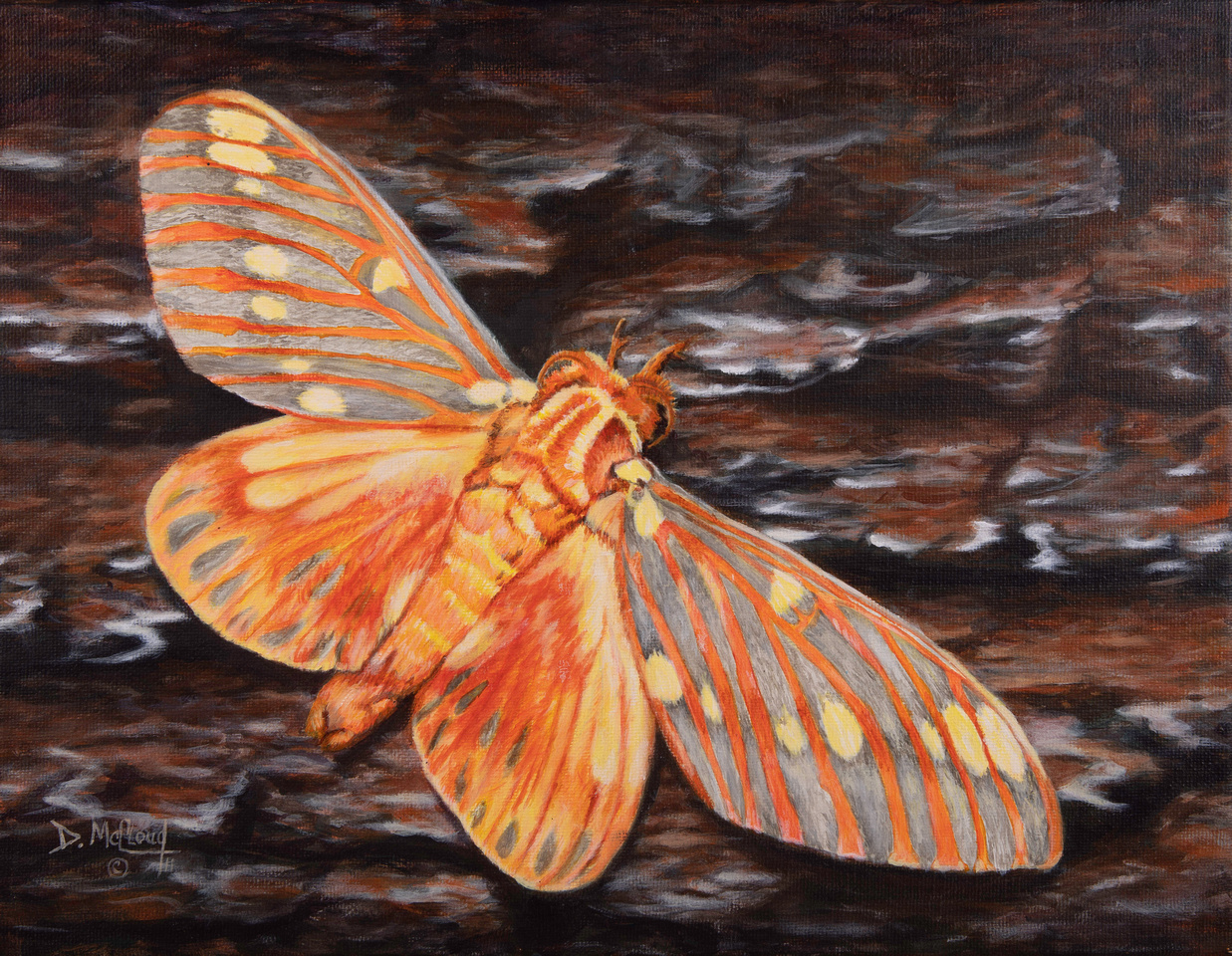If you’re a budding artist and love nature, the West Virginia Division of Natural Resources is accepting original paintings for its 2022 wildlife calendar. The submission deadline is Feb. 19. To learn more about submitting art, download our entry rules and application below. You can also contact us or call Jessica Swecker at 304-637-0245.
Art is a calling and career for West Virginia artists Gina Gunnoe and Dinah McCloud. Gunnoe is from Kanawha County and McCloud comes from Logan County, and while they have pursued different paths to achieve creative goals, both share the honor of having their work appear in the 2021 West Virginia Wildlife Calendar.
Gunnoe painted the white-breasted nuthatch for the month of January. In the painting, the chipper songbird clings to the rough bark of a tree. Nuthatches store seeds and acorns in bark furrows to eat later.
McCould painted a regal moth for the month of July. In the painting, the moth is spreading its vivid orange and yellow-spotted wings. An adult regal moth can grow a wingspan of four to six inches, making it one of the largest moths in North America.

Early creative influences
Gunnoe’s mother was an artist and her father and teachers encouraged her work. After high school, she honed her skills for three years at the Art Instruction School in Minneapolis, Minnesota.
Since childhood, McCloud loved drawing animals. At Southern West Virginia Community and Technical College, she studied painting under the instruction of respected artist and native West Virginian Lynn Ernest. She also had a unique opportunity to attend when Jerry Yarnell – host of the popular PBS TV show “Paint This with Jerry Yarnell” — served as one of the instructors at the Homecoming Hues artists’ retreat.
Creating an inspiring space
McCloud established a working studio in her home in rural Logan County. Her studio is filled with art supplies and projects. The setting surrounds her with the wild flora and fauna she loves to paint.
Gunnoe also works from a home studio, but with a twist.
“I work in my studio inside my underground home in Saint Albans,” said Gunnoe. “Yes, you read that right, I said underground. The Florida room in the front of my home lets in an adequate amount of natural lighting, ideal for my studio, let alone my jungle of plants.”
She keeps her art studio organized to avoid the distraction of searching for a brush, tube of paint or other misplaced items. Keeping the studio in good order keeps her day simpler, and that leads to smooth and seamless interactions later on.”

The process of painting
“My process of choosing a subject to paint just depends on how I feel and what I’m interested in at the moment,” said McCloud. “I take my camera with me into the hills looking for subjects like wildlife, insects, trees, plants, and so on. Sometimes the subjects come to me in my own yard.”
She selected the Regal Moth because of its beautiful colors. The wings display bright orange with gray stripes and yellow spots. The body features yellow bands and fuzzy orange horns.
“I didn’t have to go far to photograph my subject,” McCloud said. “This moth came to my residence, attracted by outside lights at night.”
Once she chooses the subject, she decides what size canvas and what type of paint. She has painted with oils alone or combined with acrylics. For the moth in the WVDNR calendar, she chose acrylic “because I feel I can do more detail work on the subject than with oils.”
Gunnoe often begins her search for a subject by making lists of animals, insects, reptiles, and other wildlife of interest. Then she tracks down photos – her own or those of other photographers who give permission — of the plants or animals as reference points.
After settling on her vision, she proportions all the elements correctly on the canvas. This crucial step must be completed first before any paint can be applied.
“I can then add my base colors and eventually start adding in layers of detailing. Detailing can be a tiring and tedious process, but it’s the icing on the cake,” said Gunnoe, who describes her style as photorealism. “I like for the finished painting to look as if the creature could almost crawl, fly, hop, or slither right off the canvas.”
For her entry for the 2021 West Virginia Wildlife Calendar, she chose to paint a white-breasted nuthatch for the first time. Gunnoe used acrylic paint on stretched 11×14-inch canvas for the bird’s portrait.
“The nuthatch is a small eye-catching bird who has a pleasant color scheme arrangement of feathers,” she said. “They have a distinct call that actually reminds me of laughter.”
Years of experience
Both artists have appeared in the West Virginia Wildlife Calendar in past years and have received numerous honors and awards.
Gunnoe’s DNR calendar work includes:
- 2018, March: Barred Owl
- 2020: May: Box Turtle
- 2021: January: White-breasted Nuthatch
See more of Gunnoe’s art works here.
McCloud’s calendar contributions include:
- 2012, September: Monarch Butterfly
- 2013, August: Praying Mantis
- 2013, May: Eastern Tiger Swallowtail Butterfly
- 2014, December: Ringneck Pheasant
- 2016, January: Beagle and Eastern Cottontail
- 2016, April: Groundhog
- 2017, June: Red Spotted Newt
- 2017, October: Elk
- 2020, December: Elk
- 2021, July: Regal Moth
Visitors to city of Logan can drop in at the local Hot Cup Coffee Shop, 201 Stratton Street, and view samples of McCloud’s works adorning the walls. Learn more about her work here.




